Thanks for visiting 24hourlondon's editorial. Download the app for #supportlocal offers and promotions.
So what IS the difference between a pub and a bar?
By Martyn Cornell - Fri, 5th Nov 2021
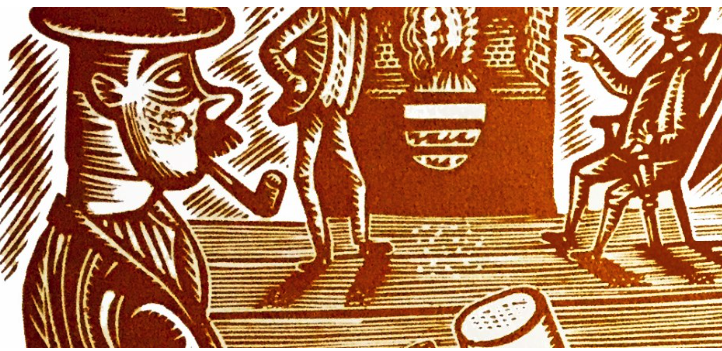
Man walks into a pub – or is it a bar? Is there a difference? Can you walk into any outlet for the retail of alcoholic refreshment on the premises and declare immediately, without discussion, disagreement or deviation: “This is a pub, not a bar!” or, conversely and contrariwise, “This is a bar, not a pub!” Is it possible to draw a line and say: “Everything this side is a pub, and everything that side is a bar”?
If you think this is a meaningless distinction, let me ask you this: does the idea of a list of Britain’s ten best pubs suggest something rather different from a list of Britain’s ten best bars? Would you expect those two lists to be identical? I don’t believe you would.
Note that little of what follows is relevant to anywhere outside Britain, and even in Scotland the line between a pub and a bar will be drawn rather differently, I suspect, than in England and Wales.
All the same, in Britain, I propose, pubs are different to bars, even if, on a Venn diagram, we might see considerable overlap. But how are they different, exactly? We’re not helped much if we try to drag the dictionaries into this argument. The OED defines “pub” as “a building whose principal business is the sale of alcoholic drinks to be consumed on the premises”, and “bar” (in the sense larger than merely “counter”) as “an establishment where alcohol and sometimes other refreshments are served.” There’s a small clue as to possible differences between pubs and bars in those almost identical definitions: a pub is “a building”, a bar “an establishment”, hinting that a bar as a separate business need not be occupying the whole of the building in which it is found. But Merriam-Webster, giving an admittedly transatlantic take on the meanings of the two words, refuses to be quite so nice: a “pub”, it says, is “an establishment where alcoholic beverages are sold and consumed”, a “bar” is “a room or establishment where alcoholic drinks and sometimes food are served”. OK, it looks as if the heirs of Noah Webster think a pub can’t be just a room, though a bar can be: but they seem to allow that a pub does not have to be a separate building. Apart from that, little difference.

The Teddington Arms, Teddington: only a pub since 2003, it was previously restaurant and, before that, a tyre depot. Its serving bar is at right angles to the road, but it has a pubby name: is it a bar or a pub?
To me, however, there is one simple test that will tell you probably 90 per cent of the time whether you are in a pub or a bar as soon as you walk through the door: where is the counter at which you stand to be served? If it’s in front of you, against the far wall, you’re in a pub. If it’s to the left or right of the entrance, at right-angles to the front of the building, you’re probably in a bar. This basic difference springs from the different origins of pubs and bars. Pubs come from the “dwelling house” tradition, where the building, often originally someone’s home, is likely to be shallower in depth than it is wide, and the longest orientation is parallel with the road or street. Thus to maximise the length of the serving area, the bar-counter runs across the back. Bars come from the “shop” tradition, where the building is more often deeper than it is wide, to maximise the number of frontages along the street. Thus the greatest length of bar-counter is achieved by running it down one of the side walls.
Of course, there are very many occasions when you’ll know without having to think very hard whether you’re drinking in a pub or a bar: if it’s a stand-alone building that looks as if, without much alteration, it could be turned into a home, it’s a pub. If it’s in a shopping parade, it has huge plate-class windows and it could easily be turned into a Starbucks or Costa, it’s a bar. But the rise of the micropub movement means it’s now less easy to declare definitively: “Pubs are descended from houses, bars are descended from shops.” Many micropubs have been converted from disused shops. Should we call them “microbars” instead? And come to that, many disused pubs, most of them stand-alone, have been converted into shops.
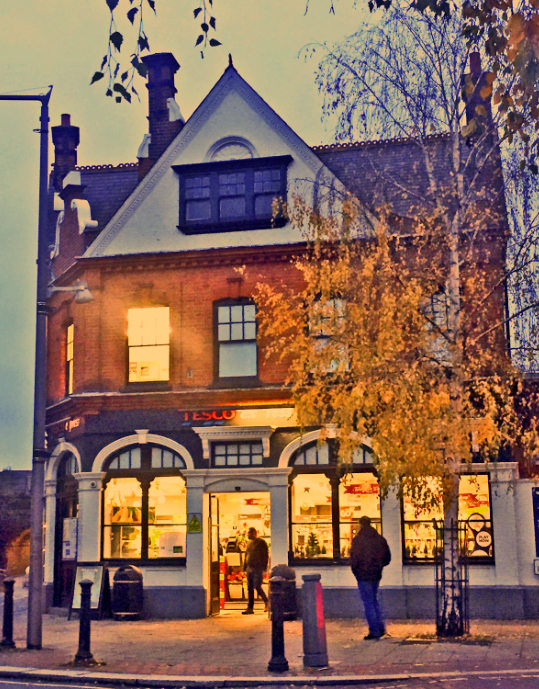
The former example of how a pub can become a shop
Not that it’s entirely true to say without elaboration that “pubs are descended from homes”. The pub as we know it today is essentially of 19th century origins, born of a four-way mating between the alehouse (strictly for locals and regulars; mostly working class; mostly rural/semi-rural, or backstreet urban; most likely to have started as somebody’s private home), the gin palace (strictly urban; showy; for both locals and strangers, working class and middle class; most likely to have been deliberately built as an outlet for drinking by a developer or entrepreneur), the tavern (High Street urban; middle class; food-oriented; original uses varying from drinking outlets attached to religious establishments to cookshops to wine retailers) and the inn (rural or urban; on a main road; mostly for travellers and occasional visitors; food important; origins in farmhouses, if rural, and private homes, if urban).
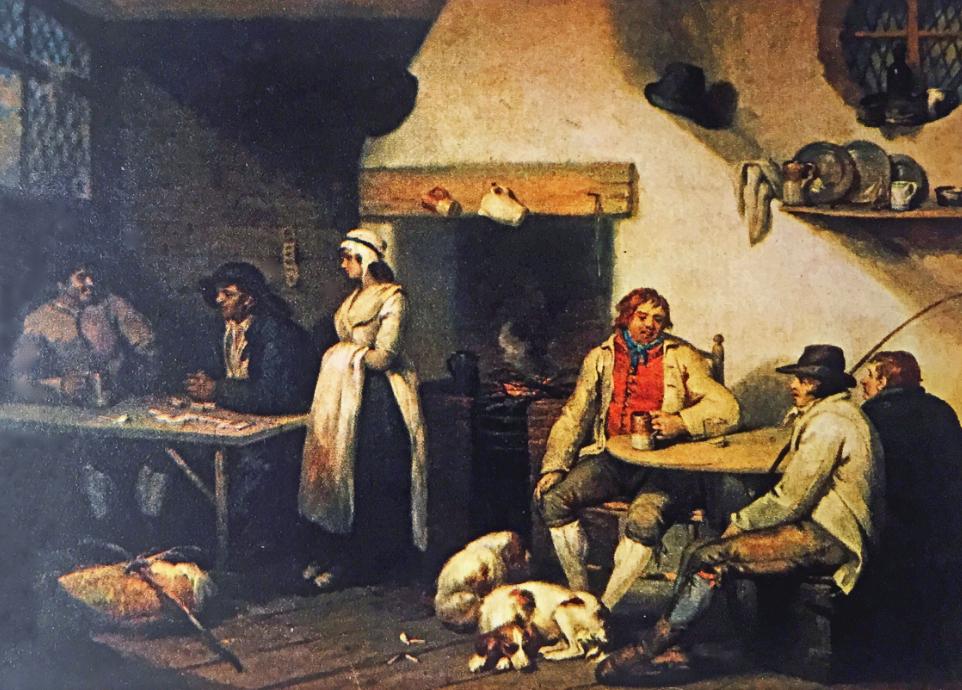
Interior of an Alehouse, oil painting by James Ward, 1769-1859: a converted home
Pubs developed to cater for a broad swath of society but still, until the 1970s, kept a strict class divide between different parts of the same building, with different rooms for different social groups, so that the working class, those who had earlier gone to the alehouse would now frequent the public bar, while middle-class drinkers, those who would once have drunk in the tavern, had taken up seats or stools in the saloon bar. But with this amalgam of different traditions, the pub architect Ben Davis said in 1961, arrived what he called “pubness”. Three of the elements of “pubness”, Davis suggested, came from the inn: a home-like character; a personal sense of welcome; a sense of permanence and continuity. Two, Davis said, came from the tavern: “an accent on good-fellowship”, by which he meant, I think, something folded into the concept the Irish spell “craic”, the idea that taverns (and pubs) are places for conversation and the enjoyment of others’ company; and “a decided affinity with Christian traditions and principles”.
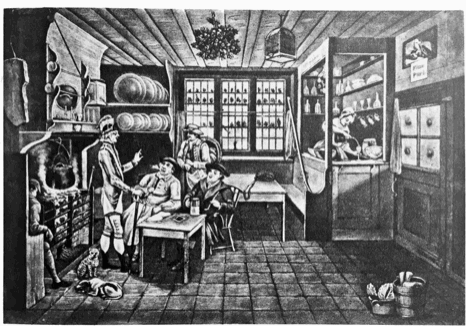
Interior of an inn circa 1800: note the bar constructed in what was obviously originally a farmhouse kitchen
Though I was brought up going to Sunday School, and with hymn singing and prayers every term-time morning before classes for 13 years of primary and secondary education, I’m not entirely sure what Davis was trying to say here: possibly that every man is equal in the eyes of the (land)lord, more likely that in the tavern (and pub) all should strive to follow the Golden Rule (the name of an excellent hostelry in Ambleside, Cumbria), that is, treat others as you would wish to be treated: “Love thy neighbour as thyself.” Acknowledge your fellow pub-goer’s right to space, to consideration, and to get served at the bar before you if he was there first.
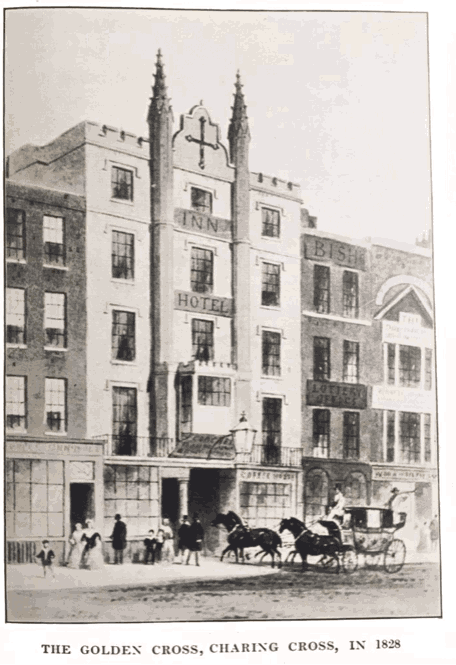
I’m in with the inn crowd … the Golden Cross inn, Charing Cross, London in 1828
Are there any of those elements of “pubness” you won’t find in a bar? It would be a very poor bar that did not have an atmosphere that included a sense of welcome and “good-fellowship”, and which oozed hostility between drinkers. But while “a sense of permanence and continuity” is not at all essential in a bar, it helps make a pub feel like a “proper” pub: the reason why the Jerusalem Tavern in Clerkenwell is so popular is because, although it is only 22 years old, it looks inside and out like a genuine 18th century establishment. (The serving bar at the Jerusalem Tavern, as it happens, is at right-angles to the street, just to show me up.) In the New Town where I grew up, all the estate pubs had been built to look like New Town homes on steroids, following the “pub as a home from home” idea, but their newness stripped them of any of the “sense of permanence and continuity” that all the pubs in the Old Town had dripping from every brick and beam, and they felt like zombie pubs, lifeless and without character. A bar, in contrast, never feels “homey”: indeed, I’d suggest that the slightest pinch, jot or iota of “a home-like character” turns a bar into either a pub or a teashop.
Pubs have regulars; bars only have customers, generally. Bars have owners, or managers; pubs can have managers, but they are often better when they have landlords, publicans or tenants, names that suggest a more proprietorial relationship with the establishment. Bars are run by people called Kenton; pubs are run by people called Sid (although this can change). Pubs have dartboards, meat raffles and piles of coins stacked up on the bar that will be pushed over by a minor celebrity one well-attended evening just before Christmas, to raise money for a local charity: these are part of “pubness” because pubs are rooted in communities in a way bars are not. Bars are places you call in to on your way home from work; pubs are places you go out to after you’ve got home from work.
* This blogpost has been reproduced with the permission of Martyn Cornell from his award-winning Zythophile blog.